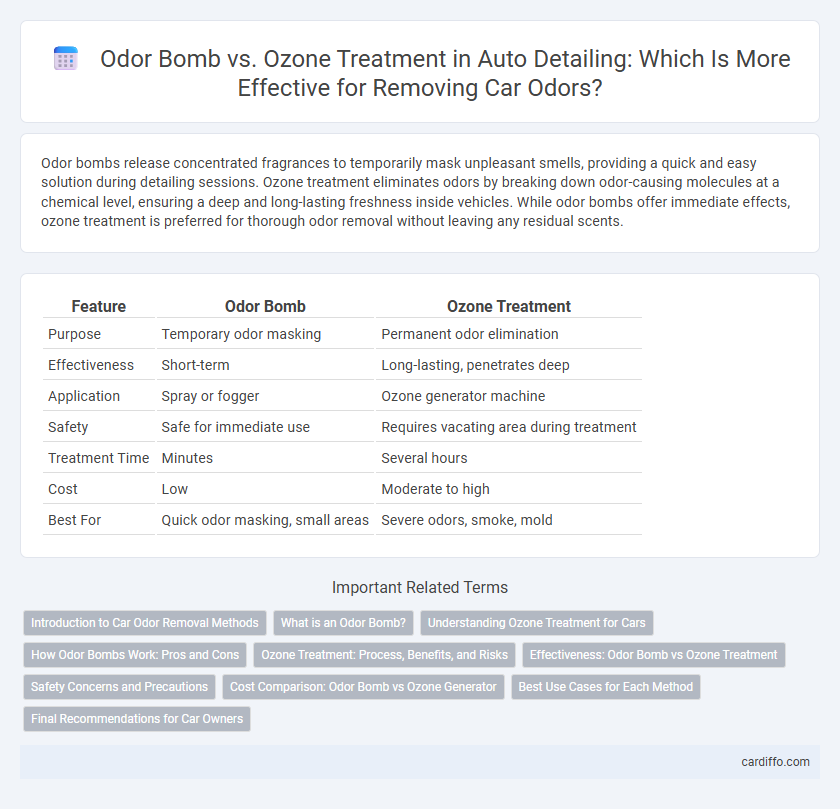Odor bombs release concentrated fragrances to temporarily mask unpleasant smells, providing a quick and easy solution during detailing sessions. Ozone treatment eliminates odors by breaking down odor-causing molecules at a chemical level, ensuring a deep and long-lasting freshness inside vehicles. While odor bombs offer immediate effects, ozone treatment is preferred for thorough odor removal without leaving any residual scents.
Table of Comparison
| Feature | Odor Bomb | Ozone Treatment |
|---|---|---|
| Purpose | Temporary odor masking | Permanent odor elimination |
| Effectiveness | Short-term | Long-lasting, penetrates deep |
| Application | Spray or fogger | Ozone generator machine |
| Safety | Safe for immediate use | Requires vacating area during treatment |
| Treatment Time | Minutes | Several hours |
| Cost | Low | Moderate to high |
| Best For | Quick odor masking, small areas | Severe odors, smoke, mold |
Introduction to Car Odor Removal Methods
Odor bomb and ozone treatment are two common methods used for car odor removal, each targeting unpleasant smells with distinct mechanisms. Odor bombs release fragrance molecules that temporarily mask odors, while ozone treatment eliminates odor-causing bacteria and volatile compounds by breaking down molecular bonds. For effective and long-lasting car odor removal, ozone treatment is generally preferred due to its ability to neutralize a wide range of contaminants inside vehicle interiors.
What is an Odor Bomb?
An Odor Bomb is a concentrated disinfectant and deodorizer that releases potent chemicals to neutralize and eliminate unpleasant smells quickly in enclosed spaces. It works by dispersing reactive agents that chemically bind with odor molecules, effectively masking or breaking them down. Commonly used in automotive detailing and restoration, odor bombs provide a fast, temporary solution for stubborn odors.
Understanding Ozone Treatment for Cars
Ozone treatment for cars uses ozone gas to neutralize and eliminate odors, bacteria, and mold within the vehicle's interior by breaking down odor-causing molecules at the source. Unlike odor bombs that temporarily mask smells, ozone treatment provides a deep, long-lasting solution by oxidizing contaminants in hard-to-reach areas such as upholstery and air vents. This method is especially effective for removing persistent odors from smoke, pets, and mildew, enhancing overall vehicle cleanliness and air quality.
How Odor Bombs Work: Pros and Cons
Odor bombs release concentrated fogs of deodorizing agents that bind to and neutralize airborne odor molecules, offering rapid and widespread odor elimination in enclosed spaces. Their advantages include quick application and effectiveness against surface-level odors, while drawbacks involve limited penetration into porous materials and potential respiratory irritation from chemicals. Optimal use requires ensuring area vacancy during treatment and proper ventilation after application to maximize safety and odor removal efficiency.
Ozone Treatment: Process, Benefits, and Risks
Ozone treatment involves generating ozone gas to oxidize and neutralize odors at the molecular level, effectively breaking down volatile organic compounds that cause unpleasant smells. This process is highly efficient in eliminating strong odors from smoke, mold, and pets, providing a thorough deodorization without leaving chemical residues. However, ozone treatment poses health risks, as high concentrations of ozone can irritate respiratory tissues and requires proper ventilation and safety measures during application.
Effectiveness: Odor Bomb vs Ozone Treatment
Odor bombs release concentrated fragrances that temporarily mask unpleasant smells but do not eliminate odor-causing particles, making them less effective for long-term odor removal. Ozone treatment oxidizes and breaks down organic molecules responsible for odors, providing a deeper, more permanent solution to eliminate tough smells in vehicles or indoor environments. Studies show ozone can neutralize up to 99% of airborne bacteria and odor compounds, whereas odor bombs primarily offer short-lived scent enhancement without targeting the root cause.
Safety Concerns and Precautions
Odor bombs release concentrated chemicals that can cause respiratory irritation and eye discomfort, requiring proper ventilation and protective gear during use. Ozone treatment, while effective in neutralizing odors, poses risks of lung damage and must be conducted in unoccupied spaces with post-treatment airing out to ensure safety. Both methods demand strict adherence to manufacturer guidelines and safety protocols to prevent health hazards.
Cost Comparison: Odor Bomb vs Ozone Generator
Odor bombs generally cost between $10 and $30 per use, making them a budget-friendly option for quick odor elimination in small spaces. Ozone generators, while requiring a higher initial investment typically ranging from $200 to $700, provide long-term effectiveness and can treat larger areas without repeated purchases. Maintenance and safety considerations for ozone generators may impact overall expenses, but their durability often leads to lower cost per treatment over time compared to single-use odor bombs.
Best Use Cases for Each Method
Odor bombs are highly effective for quick neutralization of mild to moderate odors in enclosed spaces like vehicles and small rooms, as their chemical compounds rapidly mask and eliminate unwanted smells. Ozone treatment excels in treating persistent, deeply embedded odors, such as smoke damage in homes or mold odors in HVAC systems, by breaking down odor molecules at the source with oxidative power. Choosing between these methods depends on odor intensity, space size, and sensitivity to chemicals, with odor bombs suitable for short-term use and ozone treatment ideal for long-lasting, comprehensive odor removal.
Final Recommendations for Car Owners
Car owners seeking effective odor removal should consider ozone treatment for its deep penetration and ability to neutralize persistent smells without leaving residues. Odor bombs may provide quick, surface-level masking but often fail to eliminate the root cause of smells, potentially requiring repeated use. For lasting freshness and comprehensive odor control, ozone treatment remains the preferred choice in professional car detailing.
Odor Bomb vs Ozone Treatment Infographic

 cardiffo.com
cardiffo.com